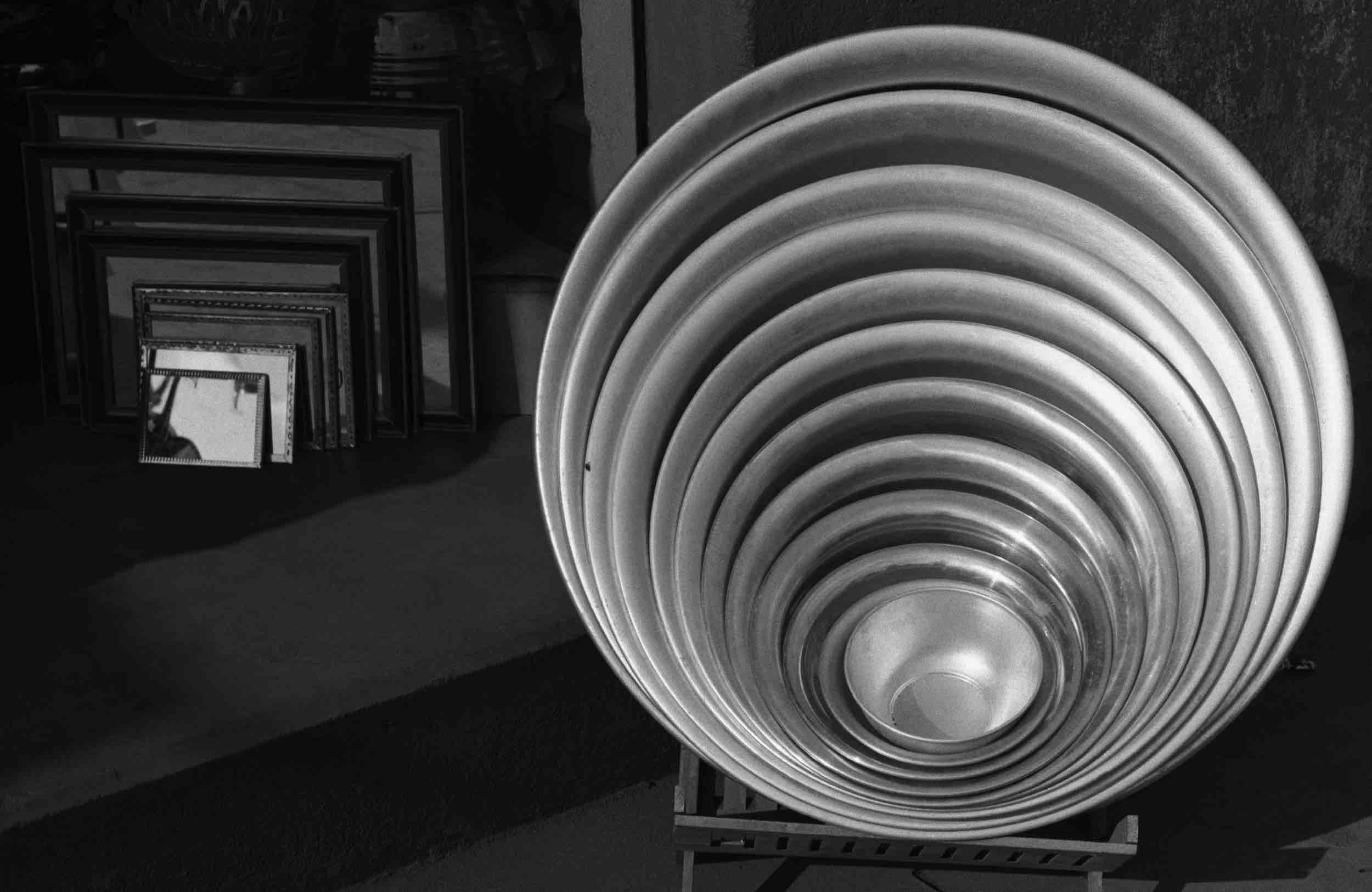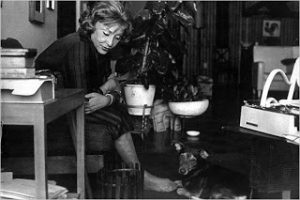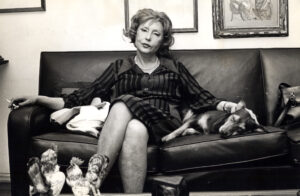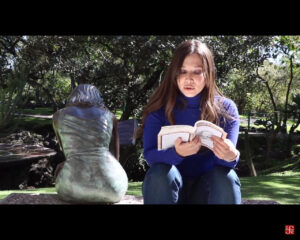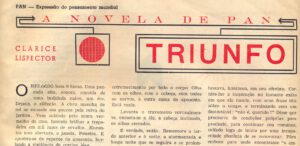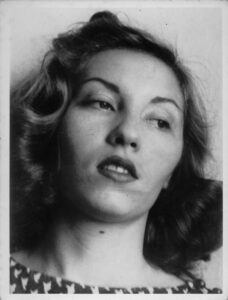Camillo Penna, João. The Symbol and the Thing. IMS Clarice Lispector, 2021. Disponível em: https://site.claricelispector.ims.com.br/en/2021/10/14/the-symbol-and-the-thing/. Acesso em: 07 January 2026.
The work of Clarice Lispector revolves around on two notions: the symbol and the thing. The thing, physics, and the symbol, metaphysics; the thing, immanence, and the symbol, transcendence; the thing, the body, and the symbol, language; the thing, existence, and the symbol, the saying; the thing, the event, and the symbol, the way to make it possible to read the nonsymbolizable thing. In Near to the Wild Heart, there is an expression repeated twice in the novel that joins the two notions: “the symbol of the thing in the thing itself.” The operation radically modifies the meaning of the Greek symballein. “Symbol” comes from the Greek symballesthai (sym-, with, and ballein, to toss, throw), “put together,” “join,” and names the natural and cosmological connection with everything (being, earth, ground). Symbol is the bond that interlaces things, and that is situated among them. It originally designates the fitting together of two halves, which the Latins called tessera. In the fitting together of two halves, one is symbol and the other is that which it symbolizes: the meaning, referent, reality, thing. The thing, the res, is the object thrown forward (the ob-jectum), which is at the root of reality. “If I had to give a title to my life it would be: in search of the thing itself,” writes Clarice in a celebrated fragment. “I want the thing itself,” she says elsewhere. Res as a legal term names the actual legal process in Roman law (the cause), and is followed in parallel by the medieval German term, Ding, Thing, which designates the assembly, the meeting, the model of the European and world parliament.
But the “symbol of the thing in the thing itself” designates a peculiar thing-symbol, at the same time physical and metaphysical, that wants to virtually erase the difference between it and the thing symbolized. It wants to annul itself as a symbol, allowing only the thing to remain. It does not, however, concern a transparent symbol, which substitutes the meaning without a remainder, a simple window for the representation of the real outside. On the contrary, this symbol contains in itself the very opacity of the remainder, of the reality of the thing, converted into a symbol. The “thing itself” is the immanent reality addressed to its own mysterious darkness, which is translated into a specific request for criticism: for it to stick to Clarice’s own terms, to be the critical symbol closest to the thing itself, which Clarice says that she wants in her writing, for it not to signify or symbolize the work, but somehow repeat it. This is what Clarice criticism has not refrained from doing in its own manner: always a little redundant in relation to the work, always presenting an associative variation based on the terms of the thing given by it. It would now be necessary to return to the thing itself, and be situated as closely as possible to it.
In a letter to Fernando Sabino, Clarice defines the symbol as a “word closest to the real name,” a unique word symptomatically forgotten or ignored, which was precisely not “the symbol of the symbol of the symbol, like other words are.” In another letter, she mentions the character of a “work that [she] was attempting and […] abandon[ed].” Actually, it concerns Lucrécia from The Besieged City. The girl was “short of spirit and very slow.” She “forced this weak spirit a lot and this gave her a sort of sanctity.” Clarice expands on the matter: the girl “forced her spirit to see reality,” her sanctity consisted in forcing herself to “be up to things.” And she quotes a phrase that will later appear modified in The Besieged City: “but it would be easier to see the supernatural than reality.” In the novel, the phrase is as follows: “But in fact it would be easier for her to see the supernatural: touching reality is what would make her fingers tremble.” The excerpt speaks of the spiritual development of the suburb, with the formation of Spiritist centers. Lucrécia pretends to hear voices to be like the other women, but she actually does not hear any, because for her, reality is more difficult than the supernatural. Years later, in her drafted talk on sorcery, Clarice will formulate something similar in definitive terms: “everything that lives and that we call ‘natural’ is, ultimately, supernatural.”
In this characteristic inversion between nature and supernature, or translating into Greek, physics and metaphysics, we get to the “crux” of the matter. For Clarice, reality, the physical thing, is essentially metaphysical. It is essentially a symbol. It is “the symbol of the thing in the thing itself,” as it is in Near to the Wild Heart, because essentially the symbol is the thing, and the thing is the symbol. This is what is literally said in The Apple in the Dark: “I wanted the symbol because the symbol is the true reality and our life is symbolic of the symbol.” But we would misunderstand the phrase if we saw in it the idealistic (or romantic) manifestation of a symbol divorced from reality; actually, it is reality itself that is symbolic.
Symbolic are the things endowed with the “mark of existence.” Near to the Wild Heart exemplifies these “visions” that cannot be confused with “miracles […] announced by the angel Gabriel.” They are repeated but seem to be seen for the first time. A dog barking silhouetted against the sky, a door swinging, “creaking in the silence of an afternoon,” an old portrait of a dead person, a bare flagpole, “upright and mute” on a summer day. Immanent faces and bodies, silhouetted against an infinite background of space and time, which when repeated show that they have always existed and that they will always necessarily exist, because “everything that existed necessarily existed.” Or women are, then, “symbol of the thing in the thing itself,” whose divinity resides in the fact that they exist more than other humans, depositaries of the power and strength that exists in all of them, even in the weakest, “slightly mothers and wives, men`s timid females.” They are all versions of the same woman (the “woman with the voice”), they all communicate with the poetry that is at the infinite bottom at the basis of life, they are all “raw material,” something that “was never realized, because its real essence was ‘becoming.’” They are an existence without essence, they are never realized, a pure “being of variation.”
In Near to the Wild Heart, this infinite basis of life is signaled in so many ways, such as the depth where the dead father’s body is lodged, the bottomless bottom of the ocean, the union of the infinite body as it bathes in the bathtub with the stars, “the confirmation underpinning everything,” which connected the sexes, the “hunger to satisfaction,” the “animal love,” the water from the rain to the sea, the children growing, the plant sprouting in the earth. Or Bach’s study (Chromatic Fantasia and Fugue in D minor [BWV 903]), which is “beneath all the realities,” as a singular and irreducible reality of “existence,” which shows that everything is perfect, because “it followed its fated path regarding itself from scale to scale.” Earth, plant, water, chromaticism, body, basis, “formless objects,” according to the Kantian formula of the sublime, with contours internal to the continuum, which situate the continuum of life, in an ontology of existence. This is the outline of Clarice’s first and only ontology.
In The Apple in the Dark, Clarice’s symbol is converted into the Christic icon. There is, in the meantime, perhaps, the definitive inflection of an insistent reading of The Imitation of Christ, the medieval method of spiritual ascesis attributed to Thomas à Kempis, which Clarice seems to have read twice (in 1946 and in 1953), as we can gather from her correspondence. Imitation as spiritual concretion is only practicable based on the doctrine of incarnation, which was invented by St. Paul, when he established the thesis according to which the invisible God is incarnated in the human icon (from the Greek eikón, image, likeness), Jesus Christ, whose passion is the greatest Western symbol. As far as the structure of the book is concerned, incarnation introduces the economy of the text as such by posing the problem of the image consubstantial with the life of the hero (the icon), in the way that it is transposed in the text. The Apple in the Dark consists of a concatenated sequence of symbols that actualize a single icon, an engraving made of “frameless cardboard,” representing the martyrdom of two medieval figures, the patron saints of shoemakers, the twins Saint Crispin and Saint Crispinian, hanging in the hut, where Martim sleeps. In the painting, the saints are seen in two stages of their lives: in one they sew shoes, and in another, “inside a smoky circle,” a convention that signals their future destiny, the two boil in a cauldron. Looking at the engraving, Martim asks himself what their “crime” was, which introduces the criminal motif of the passion that will be resumed later in The Passion According to G.H., as codified punishment, which governs the symbolic sequence, by referring to his own supposed murder of his wife.
Upon settling on the farm, Martim refuses the word “crime” and with it all forms of language, and establishes a regime of imitating things, in an evolving sequence in which he performs the “creation of what already exists.” The iconic device contains a paradox: destroying analogy through analogy itself. The first stage is the “Tertiary plot” of rocks, plants, ants, and rats. “It was a deep and watchful sleepiness, and an almost physical meditation upon his own body, in which he seemed to be attentively imitating the plants on his plot.” Next the “copy” of the cows in the corral. It is the icon of the holy shoemakers that gives Martim the perspective which allows him to “become part of that greater thing which sometimes manages to express itself in tragedy,” which embeds “the great spaciousness that can fill a church” within the world reconstructed in space, at the same time closed and infinite, of the farm’s existential laboratory. It is through the perspective of painting that Martim becomes his own name (from the Greek, martus, the “witness”), by testifying about his own passion, saving the world given as a gift to the world itself and to us, as a model of concretization of reality. It is also here that, for the literature of Clarice, the sanctity of things is converted into the anti-messianic messianism that will unfold in her best-known works, published from 1960 onwards.
In the novel, the failure is marked by Martim’s reintegration into the society he had fled, to pay for the crime he had committed, breaking the “miraculous” autarchic circle of imitation and salvation of the world. The representatives of the official society who take him to prison – the mayor, the two investigators, and the teacher – reintroducing him into the world of representation that existential imitation had abolished, reveal, in the end, that he had not in fact killed the woman as he had thought. The genetic principle of the construction of the world, the exemplary act-object that had given rise to his birth as a hero, fabricator of pure, de-subjective concretions, emptied of the burden of conscience, the pure technology that had molded the whole construction of the world imitated in the laboratory of the farm, the murder of his wife, was no more than a simulacrum. His wife was alive. Nothing had been added to the world, then, the world as it is will remain the same. The work that we have just read at this moment consists, therefore, in the pure repetition of the world, as an erasure of itself, adding nothing to the world — or, as Clarice would say — adding something else to what exists: “immaterial addition of himself.” The model of symbolic incarnation had thus failed, but the failure of the symbol consists of an ultimate symbol, a symbol so to speak destitute and naked, open, neutral, and non-heroic, which is confused with life as it is. “Eppur si muove,” says Martim at the end, repeating Galileo Galilei’s words when he retracted the heliocentric thesis before the inquisition, stating that despite what one wants to say and what he is forced to say, yes, the earth moves. The symbolic world of the farm is real. Proof of this is that Martim will write in prison the book that we are currently finishing and that returns to us its reality now converted into a symbol of the thing, as a symbol of the abolition of the symbol.
The Passion According to G.H. resumes the economy of the incarnation, as a double symbol, split into two stages: the progressive and repetitive sequence of thirty-three “chapters,” the Kabbalistic numeration of the age of Christ, as “steps” of the via crucis, in which the unspeakable event of the “infinite flesh” that occurred the day before is narrated today. The two-sided tessera joins two temporalities, in which today the inhuman nonsymbolizable thing of yesterday is said to be in the form of a human symbol. “Yesterday, however, I lost my human setup for hours and hours.” G.H. also occupies a dual position, that of an evangelist and of a subjectless subject of the passion, to which she submits a cockroach, the phobic object par excellence in Brazilian homes, with whom she lives in communion the destiny of the passion. An evangelist of herself as another, in this paradoxical “secondness,” she writes to a reader-other who accompanies her in the itinerary of the neutral, tasteless, intervalic, abyssal continuum, of the cockroach that is made of the same infinite material of which she herself is made. The symbol is a writing and speaking addressed to another. “While writing and speaking I will have to pretend that someone is holding my hand.” It is conditioned by two physical cuts: the amputation of its third leg (a condition of the movement and of the event) and the amputation of its hand (a condition of the symbol). Structurally open to the other with which one writes and which accompanies G.H., reduced to our reader’s hand inscribed in the body of the text, the symbol is a fragment removed to infinity emptied on all sides, which interrupts, for as long as it lasts, the time continuum from which it is removed.
The cockroach is prepared by the black maid, Janair, the “African queen,” who leaves recorded on her bedroom wall the diagram that contains three naked figures: the mistress, a man, and his dog. The background of the metaphysical drama of existence is the tributary regime of the slavery of maids in Brazil. The ontological schism between thing and language duplicates a schism in color and class in Brazilian society. Janair’s diagram objectifies G.H., converting her into the parasite of the semi-slave work performed by her maid. It is Janair who builds in her old room the cosmic, desert, and white space, which gives rise to the cockroach that will be eaten by G.H. in a repetition of the liturgical communion that parodies and updates the Christian ritual. The cockroach is Asian, even more archaic than the African queen, which both refer to a time before the stratified life of the rich woman who is G.H. It reveals the materiality of a non-anthropomorphic, indestructible, continuous, and eternal God, in contradiction to the biblical precepts that prohibit contact with the unclean, a God who is common, immanent, and equal to himself, from which all the different beings are made. The icon of The Apple in the Dark becomes Janair’s diagram in The Passion According to G.H. The thing is no longer imitated and becomes the writing of a graphism, a reproduction and not an expression, the translation of a telegraphic signal overdetermining everything, the terrible and wonderful revelation that the human world is inhuman, that our best is the inhuman, the “thing-part of us,” that this is God, and that we are made of God.
To the amorphous substance, to the chaos of infinite flesh, a form must be given, framing and dividing the continuum into parts, the only way to transmit what G.H. lived-saw (the hell of living-seeing-being), the only way to allow what indeed happened to exist, since without form nothing exists. However, G.H. asserts, it is necessary “to let this shape form by itself like a scab that hardens by itself, like the fiery nebula that cools into the earth.” That is: it is not any form that will be able to humanize the inhuman event, delimiting what had happened, making it transmissible and open to us. This form must be made of the same organic matter as it narrates; it must arise from within the material process itself, immanent to the process that it recounts. Clarice’s problem is transposed into G.H.’s paradox: it does not concern expressing or representing the cockroach, but about living it through a reproduction that repeats it. But the immanence of the cockroach is itself transcendent, as the white mass of the cockroach crushed by G.H. leaves the cockroach’s body. Despite not being “transcendable” – this is the difficult neologism created by G.H. – the cockroach transcends itself by being, because being is transcendence. This is the final discovery at which G.H. arrives in her itinerary. The Passion varies this dilemma in a thousand ways: what G.H. wants is identity, actuality, redemption in the present – as opposed to the eschatology of postponement, of hope, to the teleology of the kingdom of God – but this actuality only takes place in the difference from oneself and within oneself. On the other hand, transcendence must be rejected: language, the salt that adorns the taste and masks the neutral and the bland, figures a false world, made in the image and likeness of human falsehood. It is necessary to remain within what is, and transcendence must inevitably come from me like the breath of someone who is alive. But transcendence is the only way to reach the thing. The cockroach itself is a hieroglyph, a material language, encrypted and mysterious, which does not refer to a meaning, but to its own materiality as a cockroach. Language is the human way of being, as the cockroach is in its own way. “I have to the extent I designate – and this is the splendor of having a language. But I have much more to the extent I cannot designate.” Language does not designate, that is, it is not a sign or symbol. It has to fail to come to achieve what it was seeking.
But once again the incarnation fails: the spiritualization of immanent matter does not actually take place. The heroic icon is destitute. Transcendence in immanence, the structural form of Christ’s incarnation, finally unfolds into another form of transcendence, also inseparable from immanence, but which is confused with asignifying life. “Life just is for me, and I don’t understand what I’m saying. And so I adore it. – – – – – –,” and thus the conclusion of the text of the Passion is open-ended. What is lovely is the oblique, impersonal life, which implies a schism between saying and understanding, and no longer the heroic project. Clarice’s anti-messianic messianism rests on desisting from the heroic program of incarnation. Her Hasidic and Spinozan Christ is the one who is confused with the “human condition,” who does not need to be emptied of his divinity to become human (this is the meaning of kenosis, another invention of St. Paul), because all humans, like all animals, all plants, all things, are divine. The symbol’s itinerary contains, in its open-ended closure, the abandonment of the spiritual immanentization of the thing, to let the thing be, allowing us readers who share the trajectory to be able to live it.
There is a theory of the living and assigning symbol in Clarice, for example, in Água Viva. “This is life seen by life,” writes the amateur painter and writer, that is, once again: “the thing in the thing itself.” She inscribes words on the infinite surface of timeless time of the page, which works as a score in which things, when they are born, emerge from the depths from where they have come, to subsequently return there, establishing time. The already-instants are differentiated from the substratum or ultimate vibration, installing things at their birth. The plane of the “unlimited All-One” appears very early in Joana’s melody in front of the sea, in the interlacing of things, singing: “all is one,” but it is only in Água Viva that this plane materializes as formless, as a continuous and liquid object, where the forms of things are concretized in distinct series organized into sets (animals, flowers…). This is the “common ground” from where the beings that her texts set in motion arise, like themes in a formless sonorous or visual mass. Clarice explains her cosmology here. Pictorial and musical semiosis, visual and sonorous, seeks a rigorously asignifying sign, which is an index of itself, index sui. That is what Michel Seuphor’s epigraph says: “There ought to exist a painting totally free of dependence on figure – on the object – which, like music, represents nothing at all, tells no story and propounds no myth.” This writing bubbles with the incessant birth of objects seen, printed, and heard as existences. “I see that I’ve never told you how I listen to music – I rest my hand lightly on the turntable and my hand vibrates, spreading waves through my whole body: that’s how I hear the electricity of the vibration, the ultimate substratum in the domain of reality, and the world trembles in my hands.” Tactile music and “direct” painting, produced by printing the wood mold in woodcuts. A material metaphysics that seems to refuse the “bifurcation of nature,” by joining perceptual knowledge with scientific theory, according to which phenomena are constituted by electrical waves and molecules. Listening to music in this way would be to feel the acoustic waves that come to make a musical meaning.
Macabéa, from The Hour of the Star, is still an icon, but an icon closed upon itself, albeit capable of transcendence. Her sanctity is empty, purely interior, she “lived off herself as if eating her own entrails.” Macabea has her moments of ecstasy. She says a learned prayer to a God of others, but who gives her states of grace. Clarice does not aestheticize her ignorance, nor does she sweeten her precarious literacy. Clarice’s art teaches us to love poverty unadorned. “But there wasn’t any human misery in her,” writes the author (actually Clarice Lispector). It would be a weakness of the symbol to refuse Macabéa’s reality, which introduces an unavoidable concrete dimension, which requires a new symbol to speak about her. A symbol once again, and as it could not be otherwise, split, this time, between a writer/author and his creature, Macabéa, whose creation, behind the meta-textual aisles and scaffolds, we watch. Macabéa is existence itself, the “the symbol of the thing in the thing itself:” “Composed of fine organic matter, she existed. Pure and simple.”
In The Hour of the Star, one finally arrives at the cosmogonic form of a world that never began and at the same time is always beginning, where there has always been a before, which begins with a “yes” said between one molecule and another molecule, where, therefore, there have always been at least two molecules and never just one, which makes all ex nihilo creationism unfeasible. “Everything in the world began with a yes. One molecule said yes to another molecule and life was born. But before prehistory there was the prehistory of prehistory and there was the never and there was the yes. It was ever so. I do not know why, but I do know the universe never began.” Macabéa plunges “into the vastness of the musical world,” she gets emotional and falls in love with music. Her “ultimate substratum” is her “only vibration.” She also seems to deny the “bifurcation of nature” and listen to the indexical music of existence. “I just love hearing the drops of the minutes of time like this: tic-tac-tic-tac-tic.”
A list of Macabéa’s words and phrases would have to be made. Her knowledge is gathered from the old Rádio Relógio, the “perfect radio,” this radiophonic institution of chronometric time, which used to intersperse the drops of sonorous time in electronic notes, with advertising and teachings. Macabea makes them infinite. Her phrases or words infallibly restore with impressive rigor the meaning of meaning. The question about the meaning of proper names, that is, the meaning of being a person – which she said was little (“I don’t think I’m really people.”) – the meaning that is confused with the question about the meaning, and the mystery contained in the language that does not mean, contain a speculative and metaphysical formula. She who wants to buy a hole, but falls in love with the word “ephemerides.” Macabea’s time is cosmic time, by asking the unanswerable question about the meaning of things and time. Here Clarice establishes the empty, signifying symbol, the only one that would have the dignity of talking about someone who cannot yet, for the time being, read (or write) the book written about her.In her last formulation in A Breath of Life (Pulsations), a book written in partnership with Olga Borelli, and with her death, the thing finally becomes entirely spiritual. Angela, the author’s creature once again internal to the work, wants to write a book about her. And in fact, the last part of the volume left unfinished by Clarice, the “Book of Angela,” is the book of things. “The spirit of the thing is the aura that surrounds the shapes of its body. It is a halo. It is a breath.” Or else: “A thing is a mangled being. There is nothing more alone than a ‘thing.’” Once again, however, this thing-symbol, pure auratic, intervalic transcendence, is self-immanent. That is the end of this peculiar metaphysics of symbols-things: the work of Clarice.

